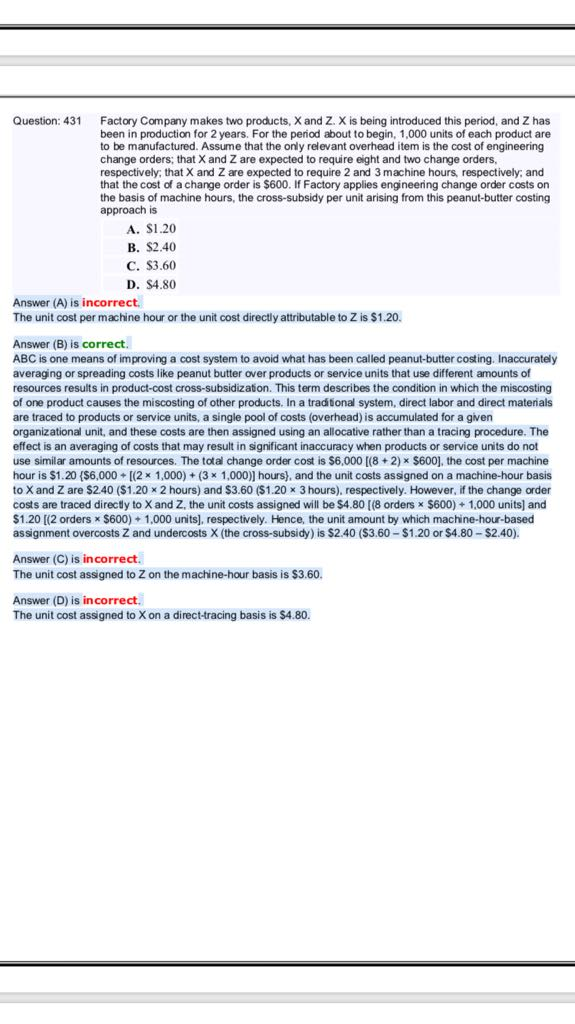 Why the answer is not A? Since the question says that the cost driver depends on the machine hour, then why just not taking the difference rate$/mh between Z and X directly? Why did they consider the change order in solving the problem?
Why the answer is not A? Since the question says that the cost driver depends on the machine hour, then why just not taking the difference rate$/mh between Z and X directly? Why did they consider the change order in solving the problem?
Question: 431 Factory Company makes two products, X and Z. X is being introduced this period, and Z has been in production for 2 years. For the period about to begin, 1,000 units of each product are to be manufactured. Assume that the only relevant overhead item is the cost of engineering change orders; that X and Z are expected to require eight and two change orders, respectively; that X and Z are expected to require 2 and 3 machine hours, respectively; and that the cost of a change order is $600. If Factory applies engineering change order costs on the basis of machine hours, the cross-subsidy per unit arising from this peanut-butter costing A. $1.20 Answer (A) is incorrect The unit cost per machine hour or the unit cost directly attributable to Z is $1.20. ABC is one means of improving a cost system to avoid what has been called peanut-butter costing. Inaccurately averaging or spreading costs like peanut butter over products or service units that use different amounts of resources results in product-cost cross-subsidizaton. This term describes the condition in which the miscosting of one product causes the miscosting of other products. In a traditonal system, direct labor and direct materials are traced to products or service units, a single pool of costs (overhead) is accumulated for a gven organizational unit, and these costs are then assigned using an allocative rather than a tracing procedure. The effect is an averaging of costs that may result in significant inaccuracy when products or service units do not use similar amounts of resources. The total change order cost is $6,000 [(8+2) x $600], the cost per machine hour is $1.20 {$6,000 + [(2 x 1.000) + (3x 1.000)] hours), and the unit costs assigned on a machine-hour basis to X and Z are $2.40 ($1.20 x 2 hours) and $3.60 ($1.20 3 hours), respectively. However, if the change order costs are traced directly to X and Z, the unit costs assigned will be $4.80 [(8 orders x $600) 1,000 units] and $1.20 [(2 orders x $600) 1,000 units], respectively. Hence, the unit amount by which machine-hour-based assignment overcosts Z and undercosts X (the cross-subsidy) is S2.40 (S3.60-$1.20 or $4.80-$2.40). The unit cost assigned to Z on the machine-hour basis is $3.60. The unit cost assigned to X on a direct-tracing basis is $4.80. Question: 431 Factory Company makes two products, X and Z. X is being introduced this period, and Z has been in production for 2 years. For the period about to begin, 1,000 units of each product are to be manufactured. Assume that the only relevant overhead item is the cost of engineering change orders; that X and Z are expected to require eight and two change orders, respectively; that X and Z are expected to require 2 and 3 machine hours, respectively; and that the cost of a change order is $600. If Factory applies engineering change order costs on the basis of machine hours, the cross-subsidy per unit arising from this peanut-butter costing A. $1.20 Answer (A) is incorrect The unit cost per machine hour or the unit cost directly attributable to Z is $1.20. ABC is one means of improving a cost system to avoid what has been called peanut-butter costing. Inaccurately averaging or spreading costs like peanut butter over products or service units that use different amounts of resources results in product-cost cross-subsidizaton. This term describes the condition in which the miscosting of one product causes the miscosting of other products. In a traditonal system, direct labor and direct materials are traced to products or service units, a single pool of costs (overhead) is accumulated for a gven organizational unit, and these costs are then assigned using an allocative rather than a tracing procedure. The effect is an averaging of costs that may result in significant inaccuracy when products or service units do not use similar amounts of resources. The total change order cost is $6,000 [(8+2) x $600], the cost per machine hour is $1.20 {$6,000 + [(2 x 1.000) + (3x 1.000)] hours), and the unit costs assigned on a machine-hour basis to X and Z are $2.40 ($1.20 x 2 hours) and $3.60 ($1.20 3 hours), respectively. However, if the change order costs are traced directly to X and Z, the unit costs assigned will be $4.80 [(8 orders x $600) 1,000 units] and $1.20 [(2 orders x $600) 1,000 units], respectively. Hence, the unit amount by which machine-hour-based assignment overcosts Z and undercosts X (the cross-subsidy) is S2.40 (S3.60-$1.20 or $4.80-$2.40). The unit cost assigned to Z on the machine-hour basis is $3.60. The unit cost assigned to X on a direct-tracing basis is $4.80
 Why the answer is not A? Since the question says that the cost driver depends on the machine hour, then why just not taking the difference rate$/mh between Z and X directly? Why did they consider the change order in solving the problem?
Why the answer is not A? Since the question says that the cost driver depends on the machine hour, then why just not taking the difference rate$/mh between Z and X directly? Why did they consider the change order in solving the problem? 





